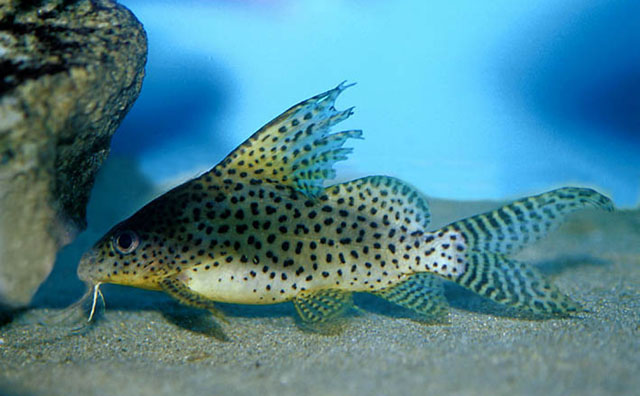| Mochokidae (Squeakers or upside-down catfishes), subfamily: Mochokinae |
| 30 cm SL (male/unsexed) |
|
benthopelagic; freshwater; pH range: 6.19999980926514 - 7.5; dH range: 15, |
| Africa: White Nile (Ref. 3202, 28714), Niger, Volta, Chad, Kwa Ibo (Ref. 57223) and Cross basins (Ref. 52861). |
|
Dorsal spines (total): 1; Anal spines: -0. Diagnosis: gill slits not extending ventrally beyond pectoral-fin insertions; eye large, its diameter 23-34.5% of head length and 48-75% of snout length; post-orbital length at least 60% of snout length; maxillary barbels unbranched, longer than head, without tubercles and bordered by a rather broad basal membrane restricted to their anterior thirds; outer mandibular barbels with simple, thin and rather long ramifications; branches of inner mandibular barbels shorter, subdivided and tuberculate; mandibular teeth slender and moderately long, numbering 39-62 (62 in the holotype); denticulations of pectoral-fin spines weak on outer margin and well developed on inner margin; dorsal-fin spine smooth anteriorly, except for a few apical denticles; humeral process triangular and not keeled ventrally; adipose fin well developed and rather close to rayed dorsal fin; branched dorsal-fin rays as well as dorsal- and pectoral-fin spines prolonged into filaments; spots present on body and fins (Ref. 57223).
Coloration: body more or less dark brown. Back, sides, head and fins with few isolated small spots; depending on individuals, spots on fins more or less aligned in series; maxillary barbels (including membranes) black; fin filaments darker than fins themselves (Ref. 57223). |
| Maximum TL was recorded at 22.2 cm, max. SL at 22.2 cm (Ref. 57223). Occurs over a muddy bottom but may also be found over rocks. Feeds mainly on insect larvae but will also take algae (Ref. 6868). This is also an upside-down species (Ref. 4537). Oviparous (Ref. 205). |
|
Least Concern (LC); Date assessed: 02 September 2019 Ref. (130435)
|
| harmless |
Source and more info: www.fishbase.org. For personal, classroom, and other internal use only. Not for publication.

